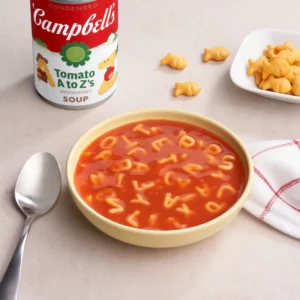Initially, I wanted to make a nice data visualization, but by my standards, it would only be cool if the data was live. There’s little glamour in loading a CSV file — even Excel can do that. However, I really struggled to find a free API that lets you make bulk requests, and I couldn’t get around the request limit without paying for it. I settled for a project on loading/displaying text, and came up with my alphabet soup idea.
I tried creating a bowl of p5 alphabet soup, which lets you add new letters by typing on your keyboard. The alphabets all float randomly on the canvas, but they can bunch together if you haven’t pressed space. When they hit space, the bunch is ‘complete’, and the next time the user types, a new bunch is created. Under the hood, each bunch is just an array of “Letter” objects, each of which have their own position and speed. At the end of every array, there’s an invisible space, which I’m moving across the screen, and all the letters simply follow the next letter in the array. A little Perlin noise and rotation is used to simulate some turbulence in the liquid.
Additionally, the user can also use the mouse to scramble the letters on the screen. If the pointer is too close to a certain Letter, the Letter is separated from the bunch and it will go on moving independently. Whether the Letter was in the active bunch or an already completed bunch, it will be extracted from its array and added to a different one called floatingLetters. In this array, all the Letter objects are always moving around randomly. Letters in this array can also be scrambled — the user just has to hover the pointer near a Letter.
The logic to make the letters bunch together was a little tricky to pin down, and a bunch in this context wasn’t really like a boid. They have to (loosely) maintain a left to right order, and that depends on which direction they’re moving in. I eventually took the gradient (speed differential) of the last letter in the array, and made the rest of the letters arrange themselves accordingly. For example, if the next Letter is moving down and right, the current Letter will be drawn slightly to the left and up. If the next Letter is moving up and right, the current Letter will be drawn slightly to the left and below, and so on. There are four such cases.
calculateNewPosition(nextX, nextY, nextSpeedX, nextSpeedY) {
this.rotation += noise(this.x * 0.01, this.y * 0.01) * 0.01;
if (nextSpeedX > 0 && nextSpeedY > 0) {
this.updatePosition(
nextX - 30 + noise(xOff) * 20,
nextY + noise(yOff) * 20
);
}
if (nextSpeedX > 0 && nextSpeedY < 0) {
this.updatePosition(
nextX - 30 + noise(xOff) * 5,
nextY + 30 + noise(yOff) * 5
);
}
if (nextSpeedX < 0 && nextSpeedY < 0) {
this.updatePosition(
nextX + 30 + noise(xOff) * 5,
nextY + 30 + noise(yOff) * 5
);
}
if (nextSpeedX < 0 && nextSpeedY > 0) {
this.updatePosition(
nextX + 30 + noise(xOff) * 5,
nextY - 30 + noise(yOff) * 5
);
}
}
This is the final sketch:
I used a font that resembles the letters in alphabet soup, and each letter also has a shadow. In real soup, letters are always going above and below the surface of the liquid, which makes sometimes makes look smaller, fainter. I think I could make this more realistic if I added varying opacity to each letter. If the Letter objects randomly had a lower opacity, it would look like they were drowning a little.


Fun sketch! This one could also use instructions for the user. Make sure you have an instructions screen in the midterm project – it’s required.